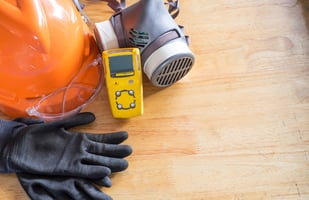In environments where the presence of hazardous gases is a constant concern, gas detectors play a...
Pre-Startup Checks
1. Check the Device for Damage
Before using a gas detector, it's crucial to inspect the device for any physical damage. Damage to the device can compromise its integrity and functionality, leading to inaccurate readings or complete failure in detecting hazardous gases. This negligence can result in undetected gas leaks, posing serious health risks or even fatal accidents
2. Check Inlet Ports for Contamination
Inlet ports must be clear of any contamination to ensure accurate gas detection. Contaminated inlet ports can block gas flow into the sensor, preventing the detector from identifying hazardous gases, which could lead to exposure to toxic or explosive environments without warning
3. Check for Flammable Atmospheres Safety Label
Ensuring the gas detector is certified for use in flammable atmospheres is critical. Using a device not certified for such environments can lead to ignition of flammable gases or vapours, causing explosions or fires
4. Check Detector is in Calibration
Calibration ensures the gas detector's readings are accurate. A detector out of calibration may give false readings, either failing to alarm in the presence of hazardous gases or triggering false alarms, leading to unnecessary evacuations or, worse, ignoring real threats
Common Gas Detector Issues and How to Troubleshoot Them by PK Safety.
5. Check All Ancillary Equipment for Damage and Functionality
Damaged ancillary equipment, such as removable pumps and hoses used, can affect the overall performance of the gas detection system. This could lead to failures in readings, that leave detectors inoperable.
To read more about the correct types of hose to use see this report from the HSE. And see the Gas Detection Checklist by All Safe Industries.
6. Check Any Accessible Filters for Blockage or Contamination
Filters protect the sensor from particulates and moisture. Blocked or contaminated filters can restrict airflow to the sensor, impairing the detector's ability to accurately measure gas concentrations. This could result in undetected hazardous conditions
Post-Startup Checks
1. Ensure the Function of Alarms
Testing the alarms ensures they are operational and can alert workers to dangerous gas levels. Non-functional alarms can lead to situations where workers are unaware of hazardous environments, increasing the risk of accidents
2. Allow the Detector Time to Warm-Up
A proper warm-up period is necessary for accurate readings. Using the detector immediately after turning it on, without allowing it to stabilise, can result in inaccurate measurements, potentially overlooking hazardous conditions
3. Check the Battery is in Good Condition
A fully charged and functional battery is essential for continuous operation. A failing battery can result in the gas detector turning off unexpectedly, leaving workers unprotected against gas exposures
4. Check the Gases the Detector is Set to Measure
It's important to ensure the detector is set to measure the specific gases present in the work environment and as per the risk assessment completed for the operation performed. Failure to do so can result in undetected hazardous gases, exposing workers to health risks or explosive atmospheres
5. Zero the Gas Detector in Clean Air
Zeroing the detector in clean air ensures that it provides accurate baseline readings. Skipping this step can lead to incorrect gas concentration readings, either underestimating or overestimating the presence of hazardous gases.
6. Perform a Pump Test
A pump test verifies that the sample draw system is functioning correctly. A malfunctioning pump can prevent the detector from drawing in air samples, leading to no detection of hazardous gases even when they are present
7. Perform a BUMP Test
A Before Use Maintenance Procedure (BUMP) test exposes the detector to a known concentration of gas to ensure it responds appropriately. Skipping this test can leave workers with a false sense of security, as the detector may not respond to actual gas exposures
In conclusion, performing these pre-startup and post-startup checks on gas detectors is essential for ensuring the safety of workers in industrial environments. Neglecting these checks can lead to undetected hazardous conditions, resulting in health risks, accidents, or even fatalities. Regular maintenance and adherence to these checks can significantly mitigate these risks and maintain a safe working environment.








